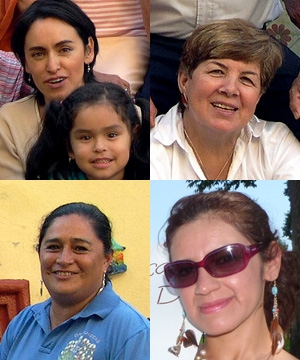
The Mexican immigrant population in the United States, in particular, experiences an unfavorable process of socioeconomic integration and, as a result, is less likely to be covered by health insurance programs, which is a major determinant in accessing medical services and enjoying long-term good health. Enrollment of Mexican immigrant women in US public health programs, in particular, is at a low level — 15 percent in 2012, according to the National Population Council of Mexico.
Demographic and Socioeconomic Overview
Mexican women comprise the largest female immigrant group in the United States. In 2011, there were 5.4 million Mexican women, constituting 47 percent of the Mexican immigrant population in the United States, according to the American Community Survey (ACS).
The composition in age and family structure of the female Mexican population emphasizes the need for reproductive, maternal, and child health services. In comparison with other female groups, Mexican women are concentrated in the middle ages of the life cycle. Eighty-six percent are between the ages of 18 and 64 years.
Mexican immigrants in general are characterized by an elevated rate of lack of legal status — 59 percent of the US unauthorized population was born in Mexico, according to 2011 estimates. Women made up 47 percent of all unauthorized immigrants, according to the Department of Homeland Security (DHS) Office of Immigration Statistics. Mexican immigrant women also had the lowest level of participation in the formal labor market. This situation is even more acute for working women with children under the age of 6 (about 35 percent), an indication that they face greater difficulty in reconciling work and child care.
Health Coverage and Use of Health Services
The Affordable Care Act signed into law in March 2010 incorporated millions of people previously excluded from the health system. However, federal law prohibits unauthorized immigrants, as well as immigrants with fewer than five years of legal residence, from accessing public benefits.
Women's use of health services varies by ethnic/racial group, age, health needs, socioeconomic and cultural factors, and technological, linguistic, and migratory factors, among others. Levels of health insurance coverage in the United States are related to processes of socioeconomic integration that also vary by ethnicity/race and migratory status. Marginalization of certain immigrant minorities is associated with exclusion from the health system.
Mexican immigrant women in the United States generally face obstacles in accessing the health insurance system. More than half lack any type of health coverage.
Mexican women are less likely to benefit from public programs for low-income families, in large part because they have not naturalized or have not completed five years of legal residence. It is not surprising that Mexican women in this situation, especially those who lack legal status, tend to delay the diagnosis or treatment of disease, and in cases where they must call on hospital centers, may face financial crisis.
The Immigrant Paradox: Health Conditions of Mexican Immigrant Women
Mexican women are in a better state of health overall than might be expected, given their socioeconomic status, low levels of health insurance coverage, and limited use of health services, according to a review of National Health Interview Survey (NHIS) data collected by the Census Bureau. Some authors refer to this as the immigrant or Hispanic paradox. However, the paradox is a multifaceted phenomenon that may be related to various factors as explored below.
There is a low prevalence of certain chronic diseases among Mexican women, such as cardiovascular diseases, cancer, or hypertension, which could be related to the younger age structure of the female Mexican immigrant population. Statistics also show that Mexican women are more likely to be diagnosed with a few diseases in particular with important implications for long-term health, for example diabetes. The incidence of diabetes is particularly elevated among Mexican women with more than ten years of residence in the United States (10 percent) when compared to non-Hispanic white women (6 percent). Among recently arrived Mexican women, only about 2 percent reported having the disease.
It is possible that the poor dietary habits acquired in the United States, combined with the effects of insufficient medical monitoring and other factors have accelerated the development of diabetes in this population. In fact, looking at the Latino population more broadly, diabetes is the fifth most frequent cause of death for Latinos living in the United States.
Positive Health Outcomes
In some areas, Mexican immigrant and Latina women experience positive health outcomes. A number of studies show positive birth outcomes such as low infant mortality rates for Latina women in general and Mexican women.
Source: Published originally on The Migration Information Source as Health Outcomes of Mexican Immigrant Women in the United States, by Paula Leite, Ma. Adela Angoa, Xochitl Castañeda, Emily Felt, Marc Schenker, and Telesforo Ramirez, April 2013.